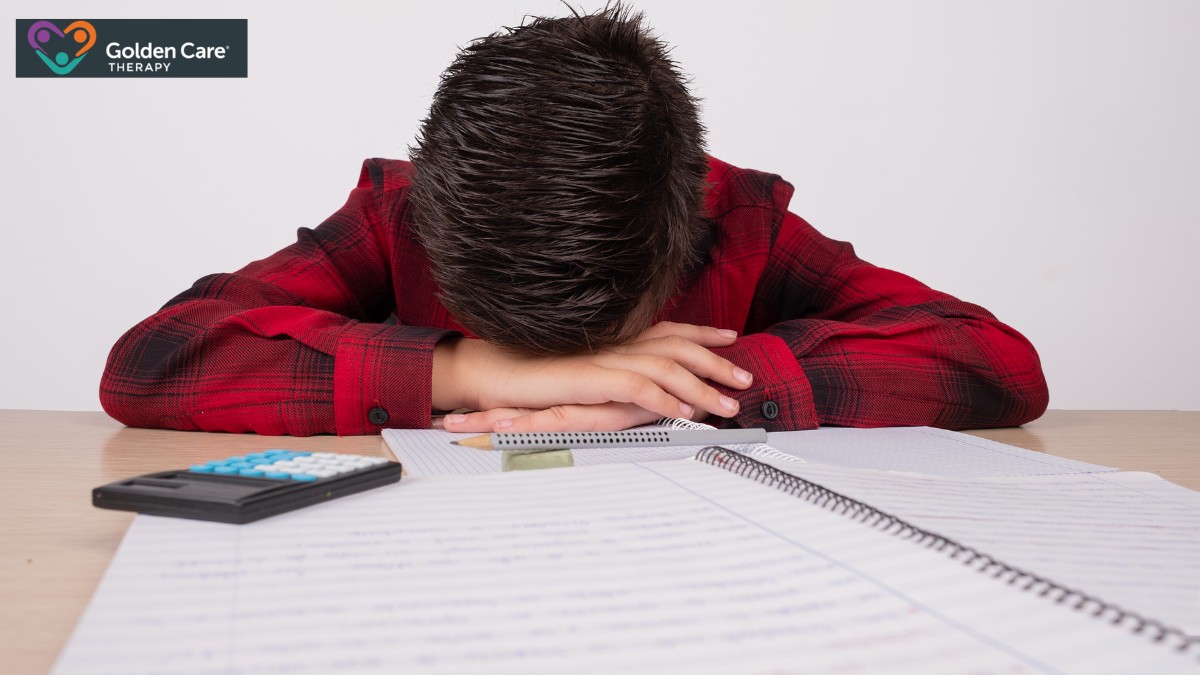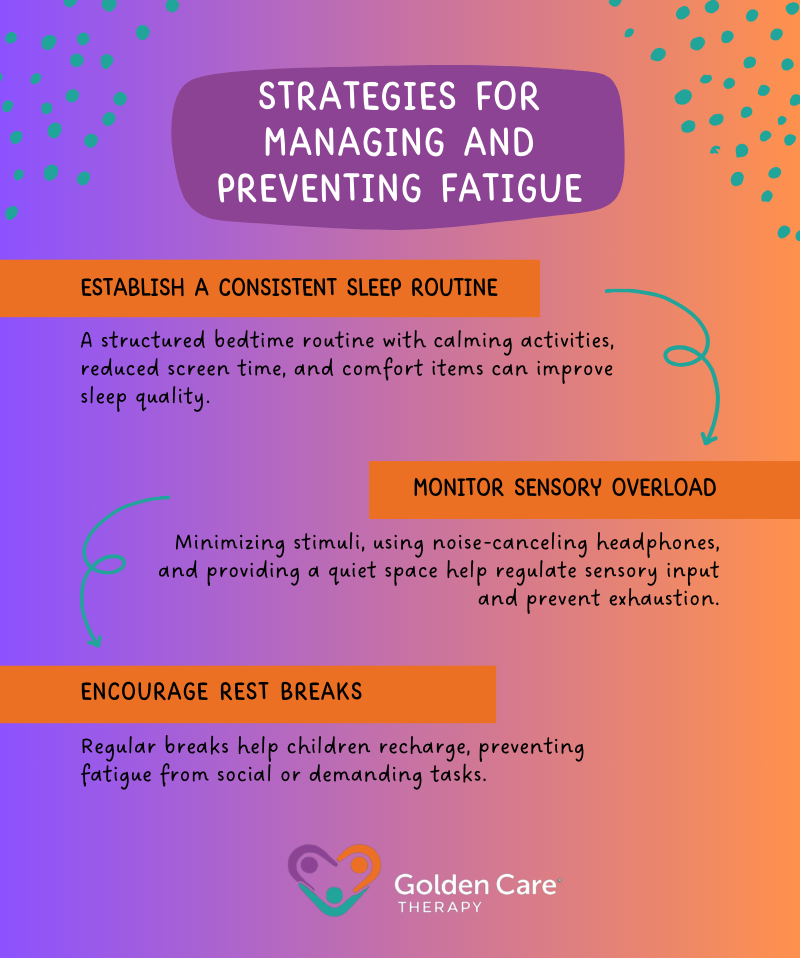Fatigue in children with autism can be complex and difficult to identify. Unlike neurotypical children, who may express feeling tired through clear verbal communication or straightforward behaviors like yawning and slowing down, autistic children often show fatigue in less obvious ways. This can be further complicated by mental health challenges, such as anxiety or sensory overload, which may mask or intensify signs of exhaustion.
Their responses to exhaustion can be tied to sensory sensitivities, difficulties with emotional regulation, and unique coping mechanisms.
Understanding the signs of fatigue in autistic children is important because untreated fatigue can lead to increased meltdowns, difficulty in learning, and overall reduced well-being. Let’s find out how you can do this.
Changes in Behavior and Mood
One of the primary indicators of fatigue in autistic children is a noticeable shift in behavior. A child who is typically calm and engaged may suddenly become irritable, restless, or withdrawn.
Some children may exhibit increased hyperactivity as their bodies try to fight off exhaustion, while others may become lethargic and less responsive to stimuli. Parents might notice a higher frequency of emotional outbursts or frustration over minor inconveniences that the child would typically handle better when well-rested.
For nonverbal children, behavioral shifts are even more critical to observe. If a child starts engaging in more frequent self-stimulatory behaviors (stimming) such as rocking, hand-flapping, or spinning, it could be a sign that they are overwhelmed and fatigued.
These behaviors can sometimes serve as a way for the child to self-regulate when they are too tired to process their environment efficiently.
Sensory Sensitivities and Overload
Fatigue can heighten sensory sensitivities in autistic children. A child who is usually tolerant of certain textures, sounds, or lights may suddenly find them unbearable when exhausted.
Sensory overload can manifest as an avoidance of bright lights, covering ears more often, or refusing to wear clothes they usually tolerate. Increased sensitivity to stimuli may lead to withdrawal, where the child avoids engaging with their environment, preferring to isolate themselves.
Parents may also observe that their child has a reduced ability to cope with everyday noises, such as background chatter, household appliances, or traffic sounds.
These noises might become overwhelming, causing discomfort or triggering distress. If a child who typically enjoys certain activities or environments starts resisting them, it could indicate that their sensory processing abilities are impaired due to fatigue.
Changes in Sleep Patterns
While fatigue is often linked to insufficient sleep, it can also result from poor-quality sleep. Many autistic children struggle with sleep disturbances, such as difficulty falling asleep, waking up frequently throughout the night, or waking up too early.
If a child who previously had a manageable sleep routine starts experiencing disrupted sleep, it might be a sign that fatigue is accumulating.
Fatigue-related sleep changes can also be observed in how a child behaves during bedtime. Increased resistance to sleep, frequent waking, or even sleeping too much can all be indicators that something is affecting their energy levels.
Some children may develop night terrors or have difficulty transitioning between sleep cycles, leading to unrestful sleep that contributes to fatigue.
Difficulty with Focus and Learning
When a child is fatigued, their ability to focus and learn diminishes significantly. Autistic children, who often rely on routine and structured learning, may struggle to follow instructions or complete tasks that they normally manage well. Their cognitive processing may slow down, making it harder to engage in problem-solving or recall information.
A fatigued child may appear to be “zoning out” during activities, staring off into space, or responding more slowly to questions.
They might struggle with transitions, finding it harder than usual to move from one task to another. This can lead to frustration for both the child and those around them, as it may appear that they are being uncooperative when in reality, their brain is simply too tired to function at its usual level.

Increased Reliance on Stimming or Comfort Behaviors
Stimming behaviors often increase when an autistic child is feeling stressed, overwhelmed, or fatigued.
If a child begins engaging in repetitive movements more frequently than usual, it may be a sign that their body is trying to compensate for exhaustion. Comfort behaviors such as sucking on a thumb, rubbing a blanket, or repeatedly watching the same video can also be indications that the child is struggling with fatigue and seeking familiar, soothing stimuli.
It is important to differentiate between regular stimming, which is a normal part of self-regulation for many autistic children, and excessive stimming which seems to interfere with daily activities. When fatigue is the underlying issue, stimming may become more intense or difficult to interrupt, signaling that the child is struggling to manage their energy levels.
Physical Signs of Fatigue
While many fatigue symptoms in autistic children are behavioral or sensory-based, there are also physical signs to watch for.
Some children may experience headaches, appear pale, or rub their eyes frequently. Others may develop dark circles under their eyes or exhibit clumsiness, tripping over objects or struggling with coordination more than usual.
Some autistic children may have difficulty recognizing and expressing their own physical discomfort, so they might not verbally communicate that they are tired. Instead, their bodies may show subtle clues, such as drooping posture, slower movements, or an overall decrease in energy levels.
Paying close attention to these physical indicators can help caregivers recognize when rest is needed.
Managing and Preventing Fatigue
Recognizing fatigue early is essential to preventing burnout and meltdowns. To help autistic children maintain healthy energy levels, caregivers can take several approaches:

Recognizing the signs of fatigue and adjusting daily routines accordingly allows caregivers to help autistic children feel more comfortable and function at their best.
Being proactive in identifying these symptoms not only supports the child’s well-being but also fosters a more predictable and manageable environment where they can thrive. At Golden Care Therapy, we provide high-quality ABA therapy in Florida, New Jersey, Indiana, New York, and Georgia, tailored to each child’s unique needs.
Our experienced therapists use evidence-based strategies to help children build essential life skills and reach their full potential. Contact us today to learn how we can support your family on this journey.
Sources:



